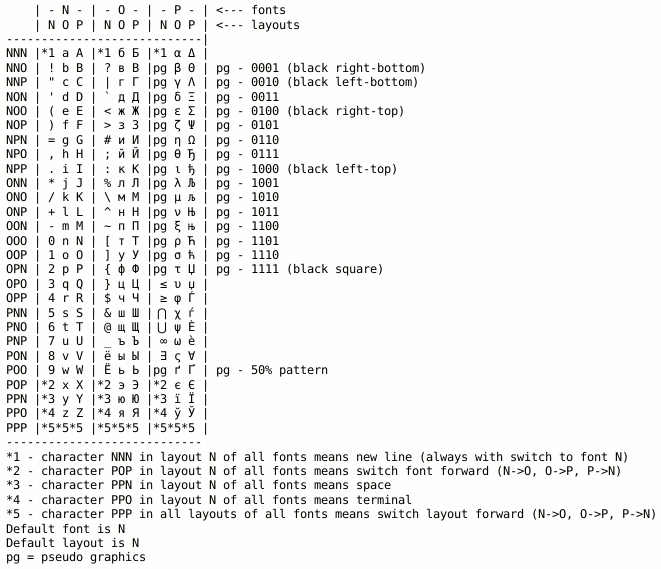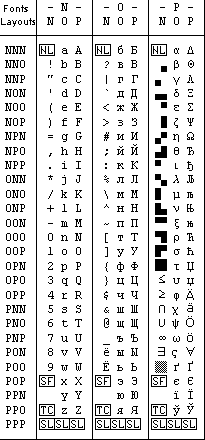-4 N: triad from memory addressed by DPn (see below);
-3 O: triad from memory addressed by DPo (see below);
-2 P: triad from memory addressed by DPp (see below);
-1 F: flag register (see below);
0 A: accumulator register;
+1 B: auxiliary register;
+2 L: lower triad of current DP register (see below);
+3 M: middle triad of current DP register (see below);
+4 H: higher triad of current DP register (see below);
Register F is set of 3 flags:
Higher trit: RSF (Result Sign Flag)
Middle trit: DPF (Data Pointer Flag)
Lower trit: BCF (Borrow Carry Flag)
There are 3 9-trit DP (data pointer) registers - DPn, DPo, DPp, available through L/M/H when flag DPF has corresponding value (N, O, P).
So full set of opcodes is:
#NNN (-13) SAN - save register A to register N;
#NNO (-12) SAO - save register A to register O;
#NNP (-11) SAP - save register A to register P;
#NON (-10) SAF - save register A to register F;
#NOO (-9) SPCD - save PC (program counter) to current data pointer;
#NOP (-8) SAB - save register A to register B;
#NPN (-7) SAL - save register A to register L (lower triade of current data pointer);
#NPO (-6) SAM - save register A to register M (middle triade of current data pointer);
#NPP (-5) SAH - save register A to register H (higher triade of current data pointer);
#ONN (-4) RLA - rotate register A to the left through flag BCF;
#ONO (-3) ADD - add register A with B and flag BCF, save result to A and BCF, modify sign flag RSF;
#ONP (-2) RRA - rotate register A to the right through flag BCF;
#OON (-1) LAI # - load register A from immediate triad;
#OOO (0) ADI # - add register A with immediate triad and flag BCF, save result to A and BCF, modify sign flag RSF;
#OOP (1) OPA # - perform unary "tritwise" operation over register A (function set by immediate triad), modify sign flag RSF;
#OPN (2) LDI # # # - load current data pointer by immediate 3 triads (higher, middle, lower);
#OPO (3) JMP # # # - jump to address set by immediate 3 triads (put it to register PC: higher, middle, lower);
#OPP (4) OPB # # # - perform binary "tritwise" operation over registers A and B, save result to A (function set by immediate 3 triad), modify sign flag RSF;
#PNN (5) LAN - load register A from register N;
#PNO (6) LAO - load register A from register O;
#PNP (7) LAP - load register A from register P;
#PON (8) LAF - load register A from register F;
#POO (9) LPCD - load PC (program counter) from current data pointer;
#POP (10) LAB - load register A from register B;
#PPN (11) LAL - load register A from register L (lower triad of current data pointer);
#PPO (12) LAM - load register A from register M (middle triad of current data pointer);
#PPP (13) LAH - load register A from register H (higher triad of current data pointer);
Today I finished full emulator of this command set! A few days ago I designed "user interface" of first prototype my ternary computer. It consists of line of ternary LEDs and line of ternary switches. 9 LEDs always display state of PC, 3 LEDs display ternary data (see below) and 3 more LEDs always display state of accumulator register A. 9 switches set some address, 3 switches set some data and 3 more switches are control ones. So we have totally 15 LEDs and 15 switches. Control switches:
1) input/output ternary switch:
P (top position) - using specified address write data to the memory (data LEDs display this 3-trit data);
O (neutral position) - ignore address and data switches (data LEDs display data from memory address PC);
N (bottom position) - ignore data switches and display data from specified address;
2) subprogram ternary switch:
P (top position) - interrupt main program, save current PC and jump to specified address;
O (neutral position) - do not disturb working program;
N (bottom position) - stop subprogram and restore PC to return to main program;
3) step/run ternary switch:
P (top position) - execute one step of the program;
O (neutral position) - pause mode;
N (bottom position) - run program from current position.
Emulation program is a little bit smaller than 1000 lines of Java-code:
http://www.nedopc.org/ternary/java.php?applet=3


 were removed and specific Finnish characters
were removed and specific Finnish characters  were added.
were added.

